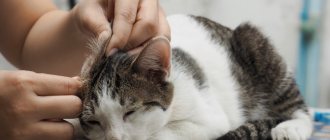Cats and cats are animals that wash themselves, carefully licking their fur. On the tongues of cats there are many hard villi located obliquely. Thanks to this structure of the tongue, the pet’s fur takes on an attractive appearance after licking. The natural lubricant produced by the animal's skin glands also has a beneficial effect on the appearance of the fur coat. Frequent washing is contraindicated for a cat, because detergents will quickly cause the fur coat to lose its appearance. There are situations when you cannot do without water. How to bathe a cat if he is afraid of water?
What to take to the bathroom
The equipment you will need to wash your cat must be prepared in advance:
- shampoo;
- rubber mat for the bottom of the bathroom;
- a towel – or better yet two;
- hairdryer (if the animal is not very afraid of it).
Remove all tubes and objects that the cat can throw off and get scared even more, sponges and washcloths so that she does not cling to them. Place a rubber mat on the bottom of the bathtub or basin to prevent the cat from slipping.
Causes of fear of water
Unlike dogs, who enthusiastically perceive water and any fun associated with it, cats have this dislike inherent in nature. But why is a cat afraid of bathing or can it react so strongly to bathing? A pet may be frightened by a change of environment, the sound of water, or unusual human behavior. Cats may be afraid not of the washing procedure itself, but of the moment of immersion in water.
Due to the transparent liquid, animals do not see the real boundaries of the water, which is why fear may arise.
Another reason for the appearance of fear is the inability to make the desired body movements. During bathing, the pet is usually held tightly by caring owners so that it cannot escape or be scratched. And for the animal this is too much stress. If there is no support nearby that the cat can cling to with its claws or it does not feel reliable support under its feet, it will also panic and meow.
The scariest thing for cats is the shower. The sound of water, according to the cat, is an aggressive creature. Therefore, you need to draw a bath without the presence of an animal, and rinse it only with a ladle.
When should you bathe a cat?
It is necessary to bathe a cat only if there are good reasons for doing so. Indications for washing your pet:
- More than 2-3 months have passed since the last bath, and the cat’s fur has become dull, darkened, and matted;
- the cat is very dirty, for example, rolled in the mud or covered in paint;
- If parasites are found in the fur, you need to immediately bathe the cat and then treat the “fur coat” with an antiparasitic agent. You should especially carefully examine cats that are often outdoors and can “catch” ticks and fleas;
- washing may be recommended by a veterinarian if a cat develops allergies, lichen, dermatitis and other skin-related diseases;
- if you find a kitten on the street and decide to take it into the house, then you cannot do without water procedures;
- In preparation for the exhibition, you will have to wash the cat with a special shampoo and give your pet a “styling.”
Why are cats afraid of water?
Only domestic cats are afraid of water, and not all of them. Wild felines such as tigers, speckled cats and jaguarundi, or domestic breeds such as Sphynx, Savannah, Maine Coon and Bengal enjoy swimming. Experts say that cats are not afraid of water; they do not understand why they should get into the water if they are already clean. Representatives of the cat family are excellent swimmers and even fish. There are two theories that answer the question asked.
Genetic memory
The ancestor of modern cats was the African Wild Cat, which lived in Africa. She ate rodents or birds and could swim and climb trees. To track down prey, and hunting is often carried out at night, it needs to sit in ambush for some time. Since wet wool does not provide warmth, and lying in one position for a long time leads to hypothermia, she preferred to avoid swimming. Also, a large number of animals came to the reservoirs, and wet fur enhanced the smell of the cat, so it could scare off its prey or attract enemies.
Natural defense reflex
Hygiene products used during bathing often irritate the cat's sense of smell with their pungent odor.
Cats' fur produces special thermal insulation, which loses its properties when wet. Cats are not dogs, they don’t know how to shake themselves off, their fur takes a long time to dry, and bathing for them is a big problem for several hours. In addition, wet wool is a good breeding ground for bacteria, and more dirt will naturally stick to it. To bathe a cat, owners use various cosmetics that have a strong odor and irritate the pet’s sensitive sense of smell.
How to wash a cat step by step instructions
https://www.youtube.com/watch?v=8jVmuWq990s
As you already understand, bathing a cat is only at first glance so simple - in fact, this activity requires patience and preliminary preparation from you. Therefore, it is better to prepare in advance in the bathroom everything that you will need during the process at different stages, so that no problems arise later.
We invite you to familiarize yourself with Astronotus: maintenance and care of aquarium fish
If you have everything prepared and know what needs to be done and in what order, you will bathe your cat quickly and without unnecessary stress, both for you and for him. So, let's look at step-by-step instructions on how to wash a cat.
How to bathe a cat that has never been washed
Of course, circumstances in life can be different: you found a stray animal on the street or you simply never washed your cat for one reason or another. The first thing you should prepare for is that a cat can be stubborn for a long time and refuse to wet its lovely paws. It is better not to turn the washing procedure into violence against the animal, but to try to lure him into the bathroom: to make him go there voluntarily. If necessary, you will have to resort to various tricks and tricks. For example, you can turn on the water in the bathroom and try to attract his attention. Despite their dislike for the water element, many cats watch the flowing streams for a long time and with great interest.
How to bathe a cat? Proper bathing, of course, begins with careful preparation. If you still managed to interest the capricious purr, get ready to act gradually. Do not try to immediately pick up the animal in your arms and plunge it into the water, this will only cause a strong attack of resistance in it. To avoid such a protest when the cat enters the bathroom, let him for a while just watch how the water flows freely and easily. You can even draw his attention to the fact that there is a calm, friendly atmosphere around, and no one is going to offend the cat. How to do it? Just talk to the animal in a gentle voice, pet it. At some point you will feel that your pet has entrusted you with his own washing, and then try to carefully but quickly do everything necessary. While bathing, continue to stroke and soothe your pet.
How often should you bathe your furry pet?
There are several opinions on this matter, which have their supporters and opponents. In fact, it is impossible to establish clear time periods during which a cat needs hygiene procedures.
The frequency of bathing cats depends on many factors. For example, one cat who lies on the couch all day long and licks himself down to the line can be bathed once a month, and this will be quite enough for him, but at the same time, if you take another cat who is lazy to lick himself after going to the toilet, he you will need to bathe more often.
How often a cat should be bathed is decided only by its owner. See for yourself, based on your pet’s character traits, the conditions in which he lives (how often he goes out for walks), and, of course, the needs of your furry friend. During such periods when your cat's fur is shedding, you can bathe him a little more often than usual to help him quickly renew his coat and cope with this problem.
But, it is worth understanding one important nuance - the fur of every cat, regardless of whether it is indoor or prefers a free life, is covered with a special, natural protective layer of secretion, which is produced by glands located in the skin of the animal.
If you bathe your cat too often, or use the wrong shampoo, you risk compromising this natural defense, which can cause health problems for your cat.
The first is a violation of thermoregulation processes. The cat’s immunity and stamina also suffer. Therefore, it is worth remembering that too frequent bathing may not be beneficial, but on the contrary, harm your furry friend.
How to prepare an animal for the procedure?
The first time a kitten is washed is usually at the age of 3-4 months. It is easier to attract children to water procedures using different play techniques. The cat's back can be moistened with water from time to time, and then gently wiped with a soft-touch cloth. You need to take some water into the basin and throw the kitten’s favorite toy in there - he will watch its movement with interest.
You should not start accustoming to water immediately after the animal appears in the house - you need to give it at least 3 weeks to get used to it. You shouldn’t start right away by immersing yourself in water - let the baby watch it and get used to the feeling of wet fur. But this should not be abused either - cats cannot be washed often, so there is no need to focus their attention on this so much.
You need to bathe your animal if:
- it is very dirty (something out of the ordinary happened to it);
- there are tangles and matted fur on it;
- have allergies and other diseases, in this case bathing is a veterinarian’s recommendation;
- before any event, for example, an exhibition.
You should not bathe a sick cat, or expose an animal that has undergone surgery to such stress. Pregnant and infirm cats are not bathed.
You need to do the following trick: even with a small kitten, you should turn on the water from time to time. If from an early age he is not afraid of the sound of water, then subsequent bathing will not expose him to such aggression.
You should not feed your cat before bathing - the last meal should occur 6 hours before the scheduled procedure. If the cat has just entered the bathroom and begins to panic, then you need to remain calm yourself. It’s worth letting him get used to it, get used to it, and talk to him kindly.
Bathing
One person can handle a calm pet. The disobedient one will scratch, pull out, and meow, so it’s better to call a helper.
Action plan:
- Place cotton balls in your cat's ears to prevent water from getting in.
- Take your pet in your arms, go into the bathroom and calmly talk to him for a few minutes.
- Close the door to the bathroom in case of escape, and so as not to later remove the soapy cat from some hiding place.
- You can use a collar or make it from ordinary fabric so that you can restrain the struggling animal. The best option is a harness that covers the chest and armpits. It is useful to have a special bath harness if your pet is bathed frequently. If you struggle too much, you can lightly press the cat to the bottom of the bath.
- Gently wet the wool. When using a shower, the stream should not be strong so as not to frighten the pet even more. If there is no shower head, use a rubber hose or a mug.
- Lather with shampoo, distributing the product along the hair growth and without touching the head. The less shampoo, the better. The product is difficult to wash out, especially from long wool. Therefore, it is better to first dissolve the shampoo in water and apply this mixture to your hair. Massage the skin well, but do not lather with circular movements or rub. The fur becomes tangled from such manipulations and is difficult to comb. All movements are in one direction according to hair growth. Hairless cats are washed with a sponge, short-haired and long-haired cats are washed with a hand or a brush.
- Wipe the head, ear area, and nose with a damp sponge.
We suggest you familiarize yourself with Oxytocin dosage for cows. Oxytocin instructions for use for cows. "Oxytocin" to intensify contractions and after childbirth: dose, technology of application
If the animal has been infected with parasites (fleas, lice eaters), you will have to wash your hair, or rather, you need to start with it. It is important to ensure that water does not get into your pet’s nose, mouth, ears, or eyes. If you wash a cat that has been treated with antiparasitic drugs, after washing the hair, soap the body, starting from the neck and down. Foam on the neck will prevent parasites from penetrating onto the head, and it is easier to fight them on the body.
There are rules to carefully learn how to bathe your cat.
Getting an unprepared cat to take a bath is a real challenge and serious stress. Such experiments can end not only with scratches on your hands, but also with a cat that will no longer trust its owner. While scratches may take a long time to heal anyway, dealing with an animal's psychological wounds takes a long time.
To avoid trouble, it is necessary to properly accustom the kitten to water procedures; it is better to follow these tactics:
- Prepare a towel in advance, open the shampoo and close the bathroom door;
- Adjust the water pressure and temperature by testing it with your hand. It should not be felt sharply on the skin;
- It is better to place the cat in the bath while holding him in your hand, which will give him less room to maneuver and scratch;
- Lather the shampoo and distribute the foam evenly throughout the body, starting from the back of the body.
- The movements should be up and down, avoiding the area around the eyes, ears and nose;
- Once completed, wrap the cat in a towel and squeeze the animal to calm it down.
- After drying with a towel, the cat can be released and sent home.
It is important to understand that time and patience are the best allies in the difficult task of getting rid of the fear of water and getting used to water procedures. But it’s worth it, because bathing will become, if not the cat’s favorite pastime, then at least tolerable. After all, cats are amazing creatures that make our lives richer, brighter and more interesting, and we ourselves are better and kinder.
Life hack: how to choose a tinted shampoo for cats of different colors
White pets are washed 2 or even 3 times with shampoo intended for white cats. When reapplying, leave the shampoo on for 2 minutes for a deeper effect, and then be sure to rinse well. White shampoo is also suitable for chinchilla and silver marbled cats, but there is no need to leave the detergent on the coat. If a cream, blue or lilac cat seems a bit dark to you, use the same shampoo to create a lighter, brighter shade.
Cats with rare red, tortoiseshell and merle colors should be washed with red or bronze shampoo. If your cat has a chocolate-colored coat, add a few drops of black to the bronze shampoo. Black shampoo is suitable for fluffy beauties of black colors.
Follow the instructions, and your cat will outshine all its relatives at the show!
How to clean your eyes and ears
The eyes need to be cleaned as dirt appears on the inner corner of the eyelid. To clean your cat's eyes, soak a clean cotton swab in warm water and wipe your cat's eyelid. Tears will do their job and specks of dust will gather in the corner of the eye.
Pets' ears need to be cleaned regularly. To make the procedure go smoothly and without stress, accustom your cat to it gradually.
At first, it is better to restrain the cat in a towel. Algorithm of actions:
- Wipe the inside of the ear with a dry cotton swab. This will help remove dust and dirt;
- Dip a clean stick in hydrogen peroxide and gently wipe the ear cavity;
- You need to move from the inside out.
Ear cleaning should occur at least once a month. And it is necessary to examine the auricle every day. There are many parasites that prefer to settle in the ear canals. Even the most well-groomed pet can become a victim of such factors. At high risk are cats that regularly walk outside.
Precautionary measures
There are cases when a cat was healthy for many years, its fur looked shiny, and suddenly it began to deteriorate: it became dull, matted, dandruff appeared, and an odor appeared. The first thing the owner hurries to do is bathe the pet. After the bath, the condition of the coat improves, but not for long. It is important to know that a sharp deterioration of the coat indicates an emerging disease or malnutrition. In this case, the best option is to consult a veterinarian for help.
To bathe or not to bathe a cat is a controversial topic. Some are for swimming, some are against. It is better to approach the issue from a position of common sense. If the animal is clean and smells good, there is no point in subjecting it to unnecessary stress. In other cases, carefully choose a shampoo and carry out the washing procedure as gently as possible for your furry friend.
Cleansing with dry shampoo
This is the simplest, most gentle way. What are its advantages over the traditional one? Using dry shampoo will not make your cat nervous, and your hands will remain intact.
You can use this product once every six months. In this case, the procedure will not become more complicated than regular combing. But you should know that if it is carried out on a carpet, then it will be quite difficult to clean it from the powder. After rubbing the shampoo a little into the animal's fur, comb it thoroughly.
Mistakes when bathing cats
Never turn the tap on all the way before putting your pet in the bath. The noise of the water will immediately frighten the cat, he will begin to meow loudly and struggle. If your pet is scared, you will have to stop using ear swabs so as not to scare him even more.
Frivolous cat owners, trying to save money on special shampoos, think that animals can even be washed... with dishwashing detergents. Do not make such a mistake under any circumstances, because the hair will become matted for a long time after using this product. Do not pour shampoo onto the fur directly from the bottle, trying to save time. This may cause skin irritation. Also, do not give your shaggy animal any sedatives before bathing, so as not to harm his health.
The first procedure for washing a cat
It is quite possible to wash a cat if he is afraid of water. The owner or hostess should prepare for this psychologically so that inevitable incidents do not come as a shock and surprise. You cannot scold an animal, let alone shout at it. It is important to show maximum patience by holding your pet tightly and constantly talking to him in a calm voice.
The correct way to hold your furry animal while washing is down and up at the same time. One hand should be under the stomach, and the other should hold the front paws. This is the only way the cat will not be able to scratch you. Lower your pet into the water as slowly as possible. If he starts to meow and struggle, calm him down in a confident but soft voice. Cats respond to the intonation of human voices and often calm down.
The fur should be slightly moistened with water, pouring from a ladle or mug, and then begin soaping. Do not allow shampoo to get on the animal's face or ears to prevent inflammation. Wash off the foam gradually until it disappears completely. If the foam is not completely washed away, the cat may swallow soap while licking the fur. After the foam is completely washed off, you need to wrap the animal in a large towel so that it absorbs as much water as possible from the fur. When the towel gets wet, it is immediately replaced with another.
When releasing a wet cat indoors, make sure that there are no drafts in the house or room, otherwise the animal may catch a cold and get sick. It is best to plant or put it in a warm place to dry out and survive stress.
List of detergents
As already mentioned, you need to use only special shampoos for cats. Even if your pet is not a purebred cat, you should not neglect its physical and mental health. If you wash a cat with ordinary soap, its fur will fade. It will quickly develop dandruff. The animal will constantly itch, which can cause not only skin irritation, but also serious illnesses.
We suggest you read: At what age can you start giving kittens food, when is it time to feed them and get them accustomed to food?
If the cat scratches and bites
In the event that an animal shows aggression, there is no need to worry while washing, pet it and say a few kind words. In general, it is advisable to start the procedure itself with this. Understand that the animal needs your support. It is known that cats, to put it mildly, do not like to wash themselves, so sometimes they need to be “persuaded” for a long time. If you keep your cat in the bath too long and he starts biting your hand, it's most likely your fault. Not a single representative of the cat breed will calmly stay in the water for half an hour to forty minutes, so keep in mind that time is limited.
Drying
After the detergent is rinsed off, you need to squeeze out the fur using stroking movements. Wrap the cat in a towel. Long-haired cats should not be rubbed with a towel - there is a high risk that the hair will become tangled. Just get wet. If one is not enough, you need to use another towel.
Short-haired cats will dry themselves without any problems. Long-haired dogs should be dried with a hairdryer on the quietest and most neutral setting, combed and applied with a spray with an antistatic effect.
Cats don't like to stay wet for long. Therefore, drying must be fast. However, cats have an ambiguous attitude towards hair dryers. If you don’t teach it from childhood, the sound and strong breath will cause fear. If you cannot use the device, it is important to comb your pet thoroughly. Until the cat is completely dry, you should not let him outside or into a draft.
If your cat trembles after washing, it means either that he is cold or that he is scared. You need to dry the animal as quickly as possible, while petting it, talking affectionately, and giving it a treat. After half an hour or an hour, the cat will stop trembling and calm down.
Maintenance and hygiene of cats
The cat is characterized as a clean and tidy animal that regularly performs hygienic care for its fluffy fur. But, due to physiological characteristics, not all parts of the body are accessible to the pet, so her beloved owner comes to her aid.
It so happens that cats, by natural instinct, are very afraid of water. And if some representatives of the genus tolerate bathing procedures more loyally, others create a real problem for their owners. At the sight of a basin of water, the cat begins a real battle: it tries with all its might to escape from the person’s hands, scratches, bites and has absolutely no control over its actions.
To calm down the furious ardor of a frightened animal, one has to use physical force, which is not very correct in relation to it. Is it possible to wash a cat in a calm environment, without violent actions towards it and injuries in the form of bites and scratches on the owner?
Some people believe that this is impossible, but this opinion is wrong! If you follow the recommendations of specialists, you can quickly accustom your pet to bath procedures and make them enjoyable for the animal. We will tell you how to do this further!











